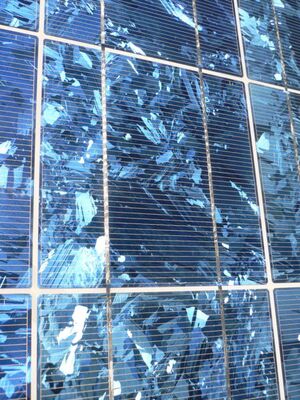Solar power describes a number of methods of harnessing energy from the light of the sun. It has been present in many traditional building methods for centuries, but has become of increasing interest in developed countries as the environmental costs and limited supply of other power sources such as fossil fuels are realized. It is already in widespread use where other supplies of power are absent such as in remote locations and in space.
Two main approaches for using solar power are direct (solar or photovoltaic cells) and indirect (letting sun heat air or heat transfer fluid and using turbines for generation).
The energy generated by solar power can be stored in batteries, or in some other form such as hydrogen, flywheels in vacuum, or superconductors. Another way is to export excess power to the power grid.
Generation[]

Polycrystalline Silicon Photovoltaic Cell
Photovoltaic cells are devices or banks of devices that use the photoelectric effect of semiconductors to generate electricity directly from the sunlight. As their manufacturing costs have remained high during the twentieth century, their use has been limited. The most important use to date has been to power orbiting satellites and other spacecraft. As manufacturing costs decreased in the last decade of the twentieth century, solar power has become cost-effective for many remote low power applications such as roadside emergency telephones, remote sensing, and limited "off grid" home power applications. Their cost has been declining steadily and is now within a factor of 2 from conventional power in many areas.
An important advantage of solar cells is their scalability. The capital costs are directly proportional to required capacity, this allows them to be used in small scales cost-effectively, but also means that there is little "economy of scale" in producing large power plants. Two problems with photovoltaic technology are that manufacturing is relatively dirty and that the cells have limited lifetime.
Solar thermal power plants generally use reflectors to concentrate sunlight into a heat absorber. Heat transfer fluid (water, old, molten salt, etc.) runs through it and is used to power a steam turbine (directly with water or via heat exchangers for other fluids).
Another potentially promising approach to solar power are solar chimneys or solar towers. In these power plants air passing under a large (2-30 square km) glass house is heated by the sun and channelled upwards towards a convection tower (up to 1 km high) where it is used to drive turbines, which generate electricity.
There are many variants of using living organisms to capture solar power - from the basic mechanism of growing trees for firewood to bacteria that produce hydrogen or other fuels.
There have been some experiments to harness energy by absorbing sunlight in a chemical reaction in a way similar to photosynthesis without using living organisms, but no practical solar chemical process has yet emerged.
Deployment of solar power[]
Deployment of solar power depends largely upon local conditions and requirements. But as all industrialised nations share a need for electricity, it is clear that solar power will increasingly be used to supply a cheap, reliable electricity supply.
- In some areas of the U.S., for example, in Southern California, which has about 260 sunny days a year, solar electric systems are already competitive with utility systems. When systems are installed at $9/watt, and utility prices are at $0.095/kWh (the current base rate), solar energy brings 9% return on investment.
- Several experimental photovoltaic (PV) power plants of 300-500 kW capacity are connected to electricity grids in Europe and the USA. Japan has 150 MWe installed. A large solar PV plant is planned for the island of Crete.
- The Australia's Solar Tower project is underway to build a 1km solar chimney. It's capacity is estimated at 200MW. The construction is expected to start in 2006 and will cost $500-750 mln. Several similar plants are planned in China. [1]
Research continues into ways to make the actual solar collecting cells less expensive and more efficient. Other major research is investigating economic ways to store the energy which is collected from the sun's rays during the day.
Photoelectric cells[]
- A system of alloys incorporating indium, gallium, and nitrogen can convert virtually the full spectrum of sunlight -- from the near infra red to the far ultraviolet -- to electrical current. Dozens of different layers could be stacked to catch photons at all energies, reaching efficiencies better than 70 percent. [2]
- Solar cells go mainstream. [3]
- Amorphous silicon, a-Si:H, promise to dramatically reduce the cost of solar cells. Whilst having efficiencies in the 10 to 12 percent range, such solar cells are vastly cheaper to produce than conventional Silicon solar cells. Rather than growing a solid uniform crystal a very thin layer of chemical-vapour-deposition Silicon is used. This is much quicker to manufacture and uses tiny quantities of refined Silicon.
Future Development[]
- Solar Towers could be used to store enegy for later use
See Also[]
- Solar-powered boat, ferry in London
